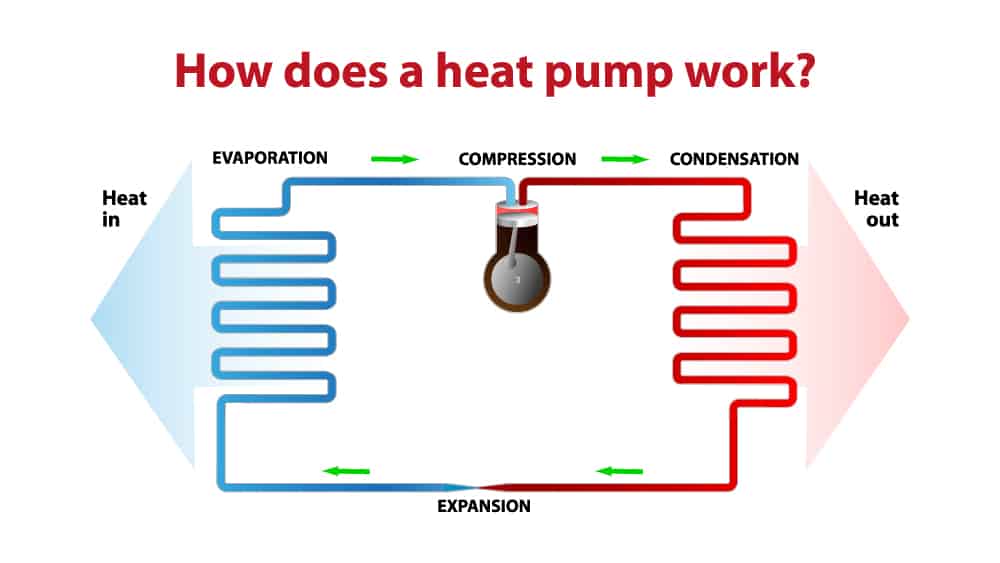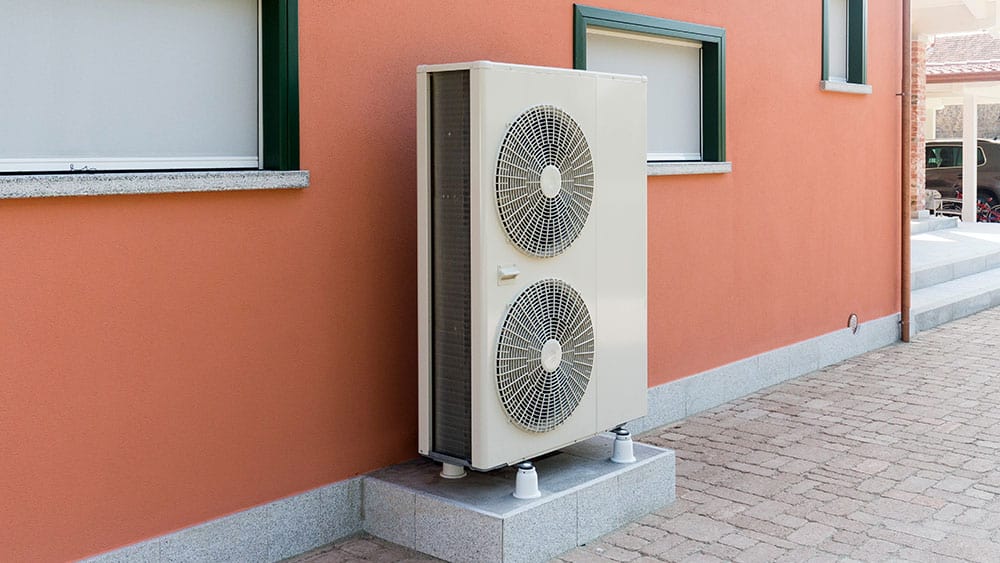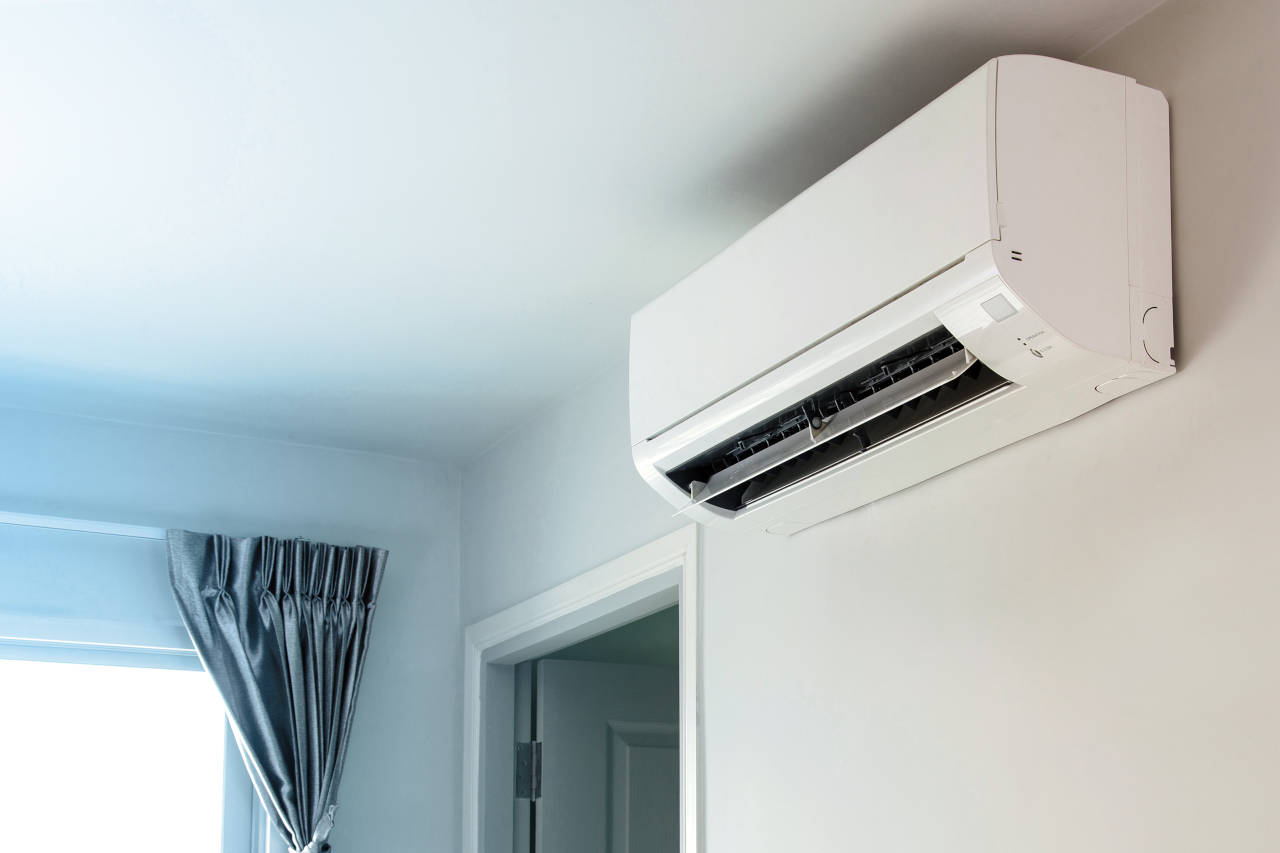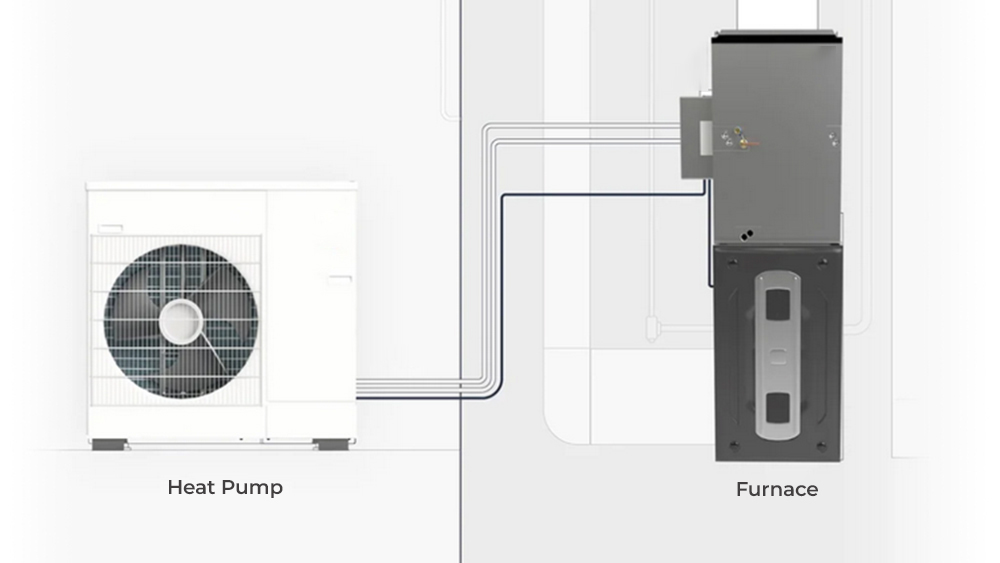
Key Takeaways
- Heat pumps are energy-efficient systems that heat and cool by transferring heat.
- Types include air, ground, water, and hybrid heat pumps.
- The best heat pump depends on your climate, home size, and budget.
Whether you are a homeowner looking to upgrade your HVAC system or an environmentally conscious individual interested in sustainable technology, a heat pump provides an efficient home cooling or heating solution. The versatility of a single system that can heat or cool an entire house is the top reason people opt for a heat pump. With an array of different types of heat pumps available, there’s something suitable for every space and situation.
To ensure you choose the best heat pump for your unique needs, it’s important to fully understand what a heat pump is and the many benefits it provides for your home.
This blog will explore how heat pumps work, the different types of heat pumps, their pros and cons, and what to look for when buying a new one.
What Is a Heat Pump?

Despite their name, heat pumps don’t produce heat; instead, they transfer heat from one location to another using electricity or other energy sources. It is typically used for heating or cooling indoor spaces. Heat pumps are known for their energy efficiency, as they can provide heating and cooling using significantly less electricity than traditional heating and cooling systems. They are commonly used in residential and commercial buildings to regulate indoor temperature throughout the year.
How Do Heat Pumps Work?

Heat pumps work by transferring heat from the air, ground, or water, depending on the type of heat pump, into your home during the winter months. It has two parts: an outdoor unit and an indoor air handler connected by a refrigerant line.
The heat transfer process takes place using a refrigerant, an HVAC component that absorbs heat from the outside air. The heat is carried from the outdoor unit to the indoor air handler, which is distributed via ducts throughout your entire home.
There are also ductless heat pumps, which do not require ductwork and deliver air directly to where it is required via an indoor air handler.
In the summer season, the heat pump takes heat from your home and expels it outside. It has a reversing valve that reverses the process by cycling the refrigerant in the opposite direction. In cooling mode, heat pumps work exactly like air conditioners.
Initially, heat pumps were only used in areas that experienced mild winters. However, advancements in technology have made them a practical option even in colder climates. Even when the outside temperature is below freezing, there is still heat in the air that can be harnessed to warm up your home. Cold-climate heat pumps can efficiently collect this heat and transfer it inside.
Different Types of Home Heat Pumps
There are three main types of ducted heat pumps: air source, water source, and geothermal. However with numerous innovations enhancing their performance, a variety of sub-types are now also available, further expanding your options when selecting the ideal heat pump system.
Here are the top heat pumps that are common in residential settings.
1. Air Source Heat Pumps

An air source heat pump (ASHP) is a highly efficient heating and cooling system that extracts heat from the outside air and transfers it into a building to provide warmth, or vice versa, to cool the building. These home heat pumps can be divided into the following two types:
- Ducted Air Source Heat Pump
The ducted air source heat pump operates similarly to a central system, featuring an outdoor unit and an indoor unit. These units are equipped with aluminum fins and coils for heat release or absorption and are interconnected by a refrigerant line filled with fluid. The outdoor unit contains a compressor responsible for compressing and circulating the refrigerant.
The indoor unit connects to ductwork inside your home, and a blower facilitates the distribution of either warm or cool air through these ducts and out of the air vents strategically positioned throughout your house. These types of heat pumps can reduce your electricity consumption by up to 65% as compared to furnaces and baseboard heating units.
You can pair this heat pump with a smart thermostat for convenience, comfort, and savings. You can control your HVAC system straight from your phone or tablet, adjusting settings to fit your schedule and preferences.
Equip your HVAC system with smart features and achieve the perfect balance between comfort & savings.
Learn more
Related: Heat Pump vs. Furnace: The Best Way to Heat Your Home
- Ductless Heat Pump

The ductless heat pump system provides both heating and cooling, similar to a ducted model, but it operates without relying on ductwork for air distribution. Instead, the outdoor unit connects to one or more individual indoor air handlers, which are installed in various areas of your house.
This approach is a practical solution for integrating a heat pump into a residence or specific zones of a home that lack ducts. Typically, these air-handler heads are positioned high on walls, but there are options to install them within the ceiling or floor. Notably, mini-split heat pumps also excel in energy efficiency compared to ducted heat pumps since they eliminate the energy losses associated with traditional ductwork.
They can be made even more energy efficient when coupled with smart thermostats for mini-splits. These devices allow you to control your heat pump using your phone from anywhere in the world. With features like scheduling, geofencing, and energy usage tracking, they can help you maintain a comfortable home climate while ensuring energy savings.
Your best choice to make any mini-split, window,
or portable AC smart. Enhance your comfort and savings.

|
Pros |
Cons |
|
|
|
|
|
|
|
|
Related: Ducted vs. Ductless Air Conditioning Systems
2. Ground Source Heat Pumps
Ground Source Heat Pumps (GSHPs), also known as geothermal heat pumps, are a type of heat pump system designed to efficiently heat and cool buildings by utilizing the stable temperature of the Earth’s subsurface. Unlike air-source heat pumps that extract heat from the outdoor air, GSHPs tap into the consistent temperature of the ground, which is mostly 40-70F all year.
Ground-source heat pumps represent a remarkable low-carbon heating solution that sets itself apart by harnessing the Earth’s natural heat through a network of pipes. Instead of relying on the combustion of fossil fuels, these systems excel at extracting warmth from the ground, offering a dual advantage of high efficiency and energy savings for your household.
According to Joshua Pearce, an academic engineer who runs the Open Sustainability Technology research group at Michigan Technological University, “Ground-source heat pumps are generally more efficient than air-source heat pumps because they rely on a more stable ground temperature.”
Milan Antoni, an HVAC professional, states, “Geothermal heat pumps are notably more efficient than air-source heat pumps, especially since ground temperatures are less erratic than air temperatures. In fact, geothermal heat pumps can boast a coefficient of performance of 4.5 or even higher. This means they can produce 4.5 times the heat energy for every unit of electrical energy consumed.”
The initial investment for a ground-source heat pump tends to be on the higher side. However, within a few years, the savings from the bills can help offset the installation cost. Another downside is that they may not be suitable for all types of soils and landscapes, as the heat-exchanging pipes have to be installed deep under the ground.
|
Pros |
Cons |
|
|
|
|
3. Water Source Heat Pumps
Water source heat pumps (WSHPs) are also highly efficient heating and cooling systems that use water as the primary heat exchange medium. They rely on a lake, river, pond, or well to exchange heat.
The heat pump is installed inside the house, and pipes run from there to the water source outside. The pipes are connected to a lake connector or a pond mat. The connector, placed at the bottom of the water source, circulates a mixture of water and refrigerant, referred to as brine.
The heat pump generates energy by circulating the brine through the collector, absorbing the heat energy from the water body. The heat energy is then passed to the compressor, which raises the temperature to a usable level and circulates it to your heat distribution system, such as a radiator or underfloor heating system.
Water source heat pumps are expensive to install and require access to a suitable water source, which can limit their applicability in certain locations.
|
Pros |
Cons |
|
|
|
|
|
|
4. Hybrid Heat Pump

In extremely cold conditions, heat pumps can face serious challenges due to the substantial temperature gap between outdoor conditions and the desired indoor warmth. The heat pump’s efficiency drops when the outside temperature plummets. This is particularly problematic for air source heat systems, which may cease operation when temperatures approach freezing, leading to the need for supplementary systems.
To address these concerns, hybrid HVAC systems present a viable solution. Hybrid heat pumps are cutting-edge solutions that combine the best of both worlds when it comes to heating and cooling your home. They mostly combine an electric heat pump with a gas-powered heating source such as a furnace. The result is a versatile and environmentally friendly heating and cooling system that can adapt to varying weather conditions.
During milder seasons, the heat pump for houses takes the lead, providing efficient heating and cooling while consuming less energy. When extreme temperatures hit, the hybrid system seamlessly switches to the furnace for added warmth, ensuring your comfort even in the harshest winter chills.
In addition to the heat pump-furnace combination, there are various other hybrid heating setups that you can consider:
- One option is the electric strip, which can be built into the heat pump indoor air handler, making it a convenient option for short cold spells.
- You can also opt for a combination of a radiator and a mini-split system. As radiators that run on gas, propane, or electric resistance heat tend to be expensive to operate on their own, you can choose to run them only on the coldest days. Your mini-split, on the other hand, will offer a more energy-efficient option for year-round heating and cooling.
|
Pros |
Cons |
|
|
|
|
|
|
5. Solar Heat Pump
These are efficient heat pumps that combine solar thermal energy with a heat pump to provide efficient heating for residential or commercial spaces. Solar heat pumps harness the sun’s energy using flat plate collectors filled with water, antifreeze, or any other liquid that has heat-absorbing properties.
This heated fluid is then circulated through a heat exchanger within the heat pump, where it transfers its thermal energy to a refrigerant. The heat pump amplifies this energy by using a compressor to raise its temperature further and then distributes it for space heating or hot water purposes. The radiant floor heating unit, baseboard heater, or furnace can be used to distribute the solar heat.
|
Pros |
Cons |
|
|
|
|
|
|
|
6. Absorption Heat Pump
Absorption heat pumps, also known as gas-fired heat pumps, operate similarly to air-source heat pumps but are powered by a heat source such as natural gas, propane, solar-heated water, or geothermal-heated water instead of electricity. Due to the prevalence of natural gas as a heat source, these systems are often referred to as gas-fired heat pumps. Additionally, absorption coolers, which function on the same principle, are available.
In residential settings, absorption heat pumps utilize an ammonia-water absorption cycle for heating and cooling. The refrigerant, ammonia, in this case, condenses in one coil to release heat. Its pressure is then reduced, causing the refrigerant to evaporate and absorb heat. When the system absorbs heat from your home’s interior, it provides cooling; when it releases heat to the interior, it provides heating.
|
Pros |
Cons |
|
|
|
|
|
|
7. Cold-Climate Heat Pumps
Cold-climate heat pumps are specifically designed to operate efficiently in lower temperatures, making them ideal for regions with harsh winters. These advanced systems can extract heat from the outside air even when the temperature drops significantly below freezing.
They utilize enhanced technology, such as variable-speed compressors and advanced refrigerants, to maintain high efficiency and heating capacity in colder climates. By providing reliable heating in winter and cooling in summer, cold-climate heat pumps offer a versatile and energy-efficient solution for year-round comfort.
These systems can achieve efficiencies of up to 400%, meaning they generate four times more energy than they consume.
|
Pros |
Cons |
|
|
|
|
Factors to Consider When Choosing a Home Heat Pump
Choosing the right heat pump for your house is essential to ensure comfort, energy efficiency, and cost-effectiveness. Several factors should be considered when choosing from the different types of heat pumps available in the market.
When purchasing a heat pump, it’s essential to consider advanced features that can enhance its efficiency, convenience, and performance. Here are some advanced features to look for:
-
Climate
Consider your local climate when purchasing your heating unit. Heat pumps work well in moderate climates, but their efficiency can vary depending on temperature extremes. If you live in an area with harsh winters, look for a heat pump with a higher heating capacity or consider a dual-fuel system that can switch to a backup heating source when needed. You can also opt for cold-climate heat pumps that can work quite well below 5 F and may even deliver heat below -20 F.
-
Size and Capacity
Size and capacity play vital roles in deciding the right type of heat pump for a house. An undersized unit will struggle to keep your home comfortable, while an oversized unit tends to cycle on and off frequently, stressing components and decreasing efficiency.
The cooling capacity of a heat pump is quantified in British thermal units per hour (Btu/hr). This value can alternatively be denoted in tons, where 1 ton corresponds to 12,000 Btu/hr. Here’s a detailed explanation of HVAC unit sizing.
It’s worth noting that heat pumps require significantly less capacity to efficiently heat a space than traditional furnaces or boilers. For instance, if your home needed a 100,000-Btu/hr. furnace, a heat pump with a 36,000-Btu/hr. capacity might suffice due to its superior energy efficiency. You would also require an undersized heat pump if you are looking to keep a backup heating system alongside your heat pump.
-
Compressor Type
The compressor plays a pivotal role in a heat pump as it’s responsible for moving the heat. In basic heat pumps, you typically find a single-speed compressor, which operates in a binary fashion – it’s either on or off. While this system can adequately heat or cool your home, it tends to lead to fluctuations in both temperature and relative humidity as it cycles on and off. Some heat pumps are equipped with two-speed compressors, which help reduce these temperature swings to some extent.
A better option is a variable-speed compressor. This type of compressor adjusts itself over time, running constantly to deliver just the right amount of heating or cooling to maintain a comfortable indoor temperature. What’s more, variable-speed compressors are highly energy-efficient as it takes less energy to move a small amount of heat over some time than a lot of heat at once. These systems also work well with zone control systems.
-
Efficiency
In heating mode, the heat pump efficiency is determined by the heating seasonal performance factor (HSPF) rating. In cooling mode, efficiency is commonly expressed as the seasonal energy-efficiency rating (SEER). Higher SEER and HSPF ratings indicate better energy efficiency and lower operating costs. Most efficient heat pump models have SEER of 33.1 and HSPF of 14.
-
Cost
When deciding on the type of heat pump for your home, always consider both the upfront cost and its long-term operating expenses. Higher-efficiency models designed to heat and cool your entire home will cost more than a mini-split heat pump intended for a specific area. You should also consider potential rebates or incentives offered by local utilities or government programs.
Choosing the Right Heat Pump
Heat pumps have become a popular choice for heating and cooling homes, as they are efficient and environmentally friendly. There are different types of heat pumps available in the market.
Air-to-air heat pumps transfer heat between the outdoor air and your home’s indoor air. Water source heat pumps are ideal for homes near a natural body of water or with a well. Geothermal heat pumps use the constant temperature of the earth to heat and cool your home efficiently. Selecting the right home heat pump involves careful consideration of various factors. These include the climate you live in, the availability of ducts, efficiency, size, capacity, and more. Ultimately, consulting with a qualified HVAC professional can be quite helpful in assessing your specific needs and ensuring the ideal heat pump solution for your home.








